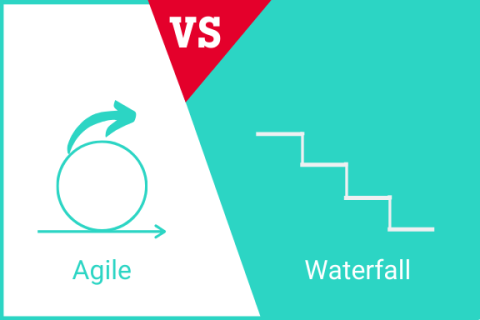Agile vs Waterfall methodology: when should you use them?
Back to overview-
Digital Marketing
As seen previously, the agile process is value based, highly adaptable, and focused on getting good product to the user as quickly as possible. This methodology is compared against the traditional “waterfall” model.
What is the waterfall model?
Considered the classic process model, the waterfall model is based on phases. It is very simple in that each phase must be completed before beginning the next. This is because the output of the first phase is required input for the next. There is no overlap, and the flow is direct, like the path of a waterfall.
The waterfall method has advantages, mainly that it is easy to understand, execute, and measure. However, it is not the best method for all projects, as was seen in the 1990’s. It doesn’t allow for adaptation for feedback or error correction, and can be slow. There are times when the waterfall method is appropriate for project management, though the agile method has become increasingly more popular for many types of projects.
When should you use the waterfall method?
The waterfall approach is an appropriate method for a well-defined project with little uncertainty. Examples of this could be building a house or organising a conference.
How does it work? First, the scope of the project is defined. This is the end vision of the final product, and it will not change. This would mean that, in the case of building a house, you can not later change the number of windows, or in organizing a conference, you cannot change the location nor the subject. As for the project implementation schedule, it is a limiting factor in either absolute (like in the case of a conference) or almost absolute. With a well-defined scope, the main challenge facing a Project Manager or Portfolio Manager is to plan all types of resources over time and across parallel projects while aligning with the required sequence of actions in each particular project.
With the example of constructing a house: the workers responsible for the delivery of the cement must perform their tasks on time because the cement phase must be completed before the next phase can begin. Any delay caused by the lack of cement resources can jeopardize the smooth running of the work of the masons, which could lead to a domino effect down the line, causing delays for everyone. Also, once the concrete is solid, the cement workers must already be on another job site.
When should you use the Agile framework?
An agile process methodology should be used in the management of projects whose deadlines are fixed. In this case, the resources are a determining factor and the scope is a topic of planning (prioritization).
Examples could be software development (working in sprints), publication (date of publication of magazines or newspapers) and marketing content (marketing campaigns).
The technique is limited by well-defined deadlines and resources. Scrum masters and team members, who have similar roles, prioritize what will be delivered in the next sprint, or defined time period of usually no more than a couple weeks. The Scrum master typically has different backlog lists and Scrum boards for different types of resources (bug fixes and feature requests in the area of software development, or political and sports content in the area of publishing).

So, Agile or Waterfall?
Both Waterfall and Agile have their strengths and weaknesses. In the end, the choice depends greatly on the nature of the project and the market in which it will evolve.
A project that is very structured in a stable market doesn’t necessarily need to be conducted in an agile way--and will likely benefit more from the organization and structure of cascading methods.
On the contrary, a project that requires faster development to enter a market subject to many changes will have a lot to gain from being part of an agile development philosophy. Such a project will perfectly benefit from the strengths of agility, where speed and flexibility are essential to success in this type of market.
This is why an agile mode is more widely preferred in IT software development market, because of the constant changes to which companies are subject and fierce competition that characterizes the market. In all cases, choosing one or the other will influence team structure and how the project will be managed, both internally and with the end customer.
Generally, all organizations have different types of projects that require the use of both methodologies to establish effective work processes. The first method is not necessarily better than the second, but each one simply allows to answer to different challenges. High quality resource planning combined with a timeline is essential for any project managed by the Waterfall Method and in particular project portfolio planning. Unlike the traditional waterfall approach, the Agile approach will offer greater flexibility and visibility in project management.
The choice is yours.
Looking for an experienced Agile Project Manager for your project team? You've come to the right place!




